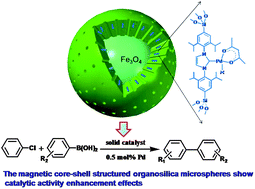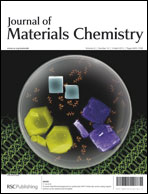New magnetic core–shell-structured nanoporous organosilica microspheres consisting of a Fe3O4 core and an organosilica shell with a built-in N-heterocyclic carbene (NHC) moiety were synthesized through surfactant-directed self-assembly on surface. The structure and composition of the material thus-designed were confirmed by N2 sorption, XRD, TEM, FT-IR, etc. Such composite microspheres possess highly open mesopores (1.6 nm) in the shell, moderate surface area, tunable shell thickness, uniform morphology, high magnetization as well as good coordination ability toward Pd. The catalytic activity test with the Suzuki–Miyaura couplings of challenging aryl chlorides reveals that this Pd-coordinated material is highly active for a wide range of substrates, suggesting highly promising application potentials of the magnetic core–shell-structured nanoporous organosilica. In particular, the catalyst derived from this material is superior to NHC-functionalized MCM-41 microspheres and a commercial Pd/C catalyst in terms of activity and recovery. The catalytic activity enhancement effects may be attributable to the purposely designed core–shell structure with significantly decreased diffusion depth, which is crucial for designing high-performance solid catalysts.

You have access to this article
 Please wait while we load your content...
Something went wrong. Try again?
Please wait while we load your content...
Something went wrong. Try again?


 Please wait while we load your content...
Please wait while we load your content...